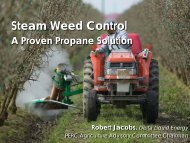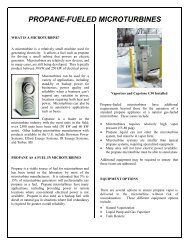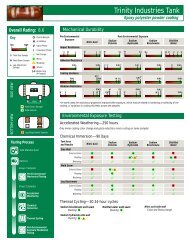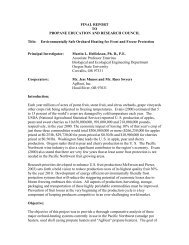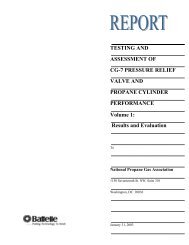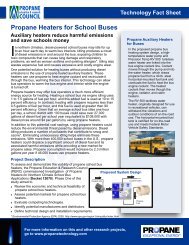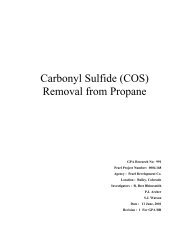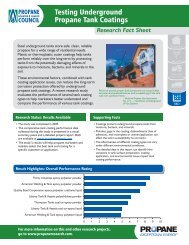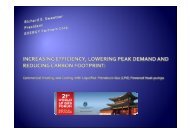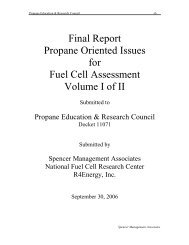Code Approval of Composite Propane Cylinders for Indoor Use ...
Code Approval of Composite Propane Cylinders for Indoor Use ...
Code Approval of Composite Propane Cylinders for Indoor Use ...
Create successful ePaper yourself
Turn your PDF publications into a flip-book with our unique Google optimized e-Paper software.
Table 8. Summary <strong>of</strong> Test Type 1 ResultsTestNumberCylinderDesignMax. Heat ReleaseRate (kW)Max. SmokeRelease Rate (m 2 /s)Observations1 1 113 0.65 Melting and dripping.Pool fire size approx 3 ft 2 .2 1 98 0.64 Melting and dripping.Pool fire size approx 3 ft 2 .3 2 111 2.65 Melting and dripping.Pool fire size approx 1 ft 2 .4 2 119 2.30 Melting and dripping.Pool fire size approx 1 ft 2 .Test Type 2 TestsIn tests making up Test Type 2, a heating appliance with the composite cylinder was tested in anNFPA 286 configuration test room with the cylinder exposed to a standard igniter. In this test,the test room was lined with gypsum wallboard. The appliance was located in the corner facingthe open doorway. In one test, an additional spare cylinder, positioned next to the heater, wasexposed to the igniter. The increases in temperatures and heat flux in the test room, as well aspressure in the gas cylinder were measured.The data from these tests are summarized in Table 9.Test Type 3 TestsIn tests making up Test Type 3, the fire per<strong>for</strong>mance <strong>of</strong> the heating appliance with composite gascylinder was assessed in a room fire scenario that grows to flashover conditions. In this test suite,the test room was lined with medium density fiberboard. The heating appliance incorporating acomposite gas cylinder was positioned against the wall facing the open doorway. A 300 kW or a40-160 kW propane burner located in the corner <strong>of</strong> the room was used to ignite the mediumdensity fiberboard resulting in flashover conditions in the test room. In one test, an additionalspare cylinder was positioned next to the heater. The increases in temperatures, ensuing from thefire growth, were measured and the per<strong>for</strong>mance <strong>of</strong> the heating appliance was assessed.The results from Test Type 3 are provided in Table 10.<strong>Composite</strong> <strong>Propane</strong> <strong>Cylinders</strong> 38February 2007<strong>for</strong> <strong>Indoor</strong> <strong>Use</strong> — Phase IIBattelle



